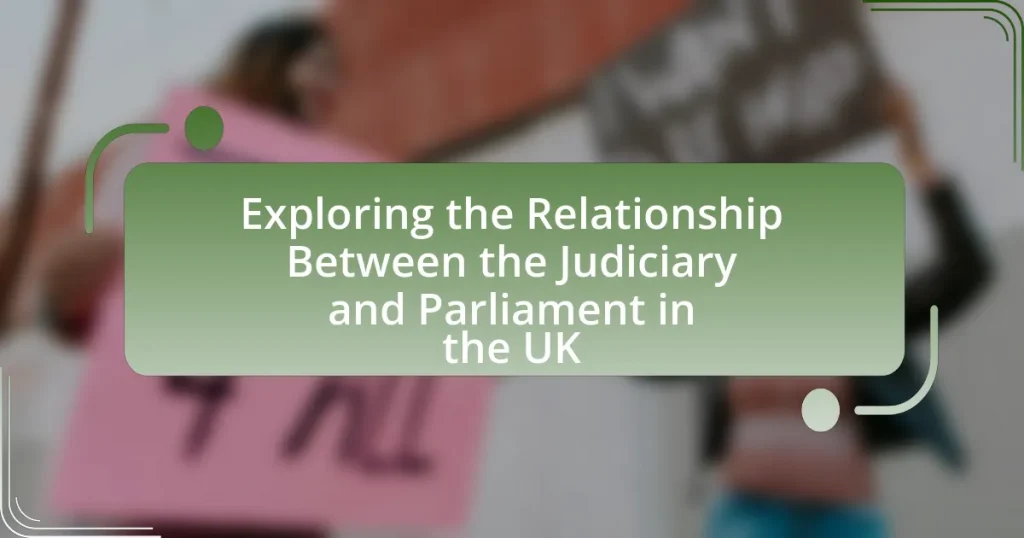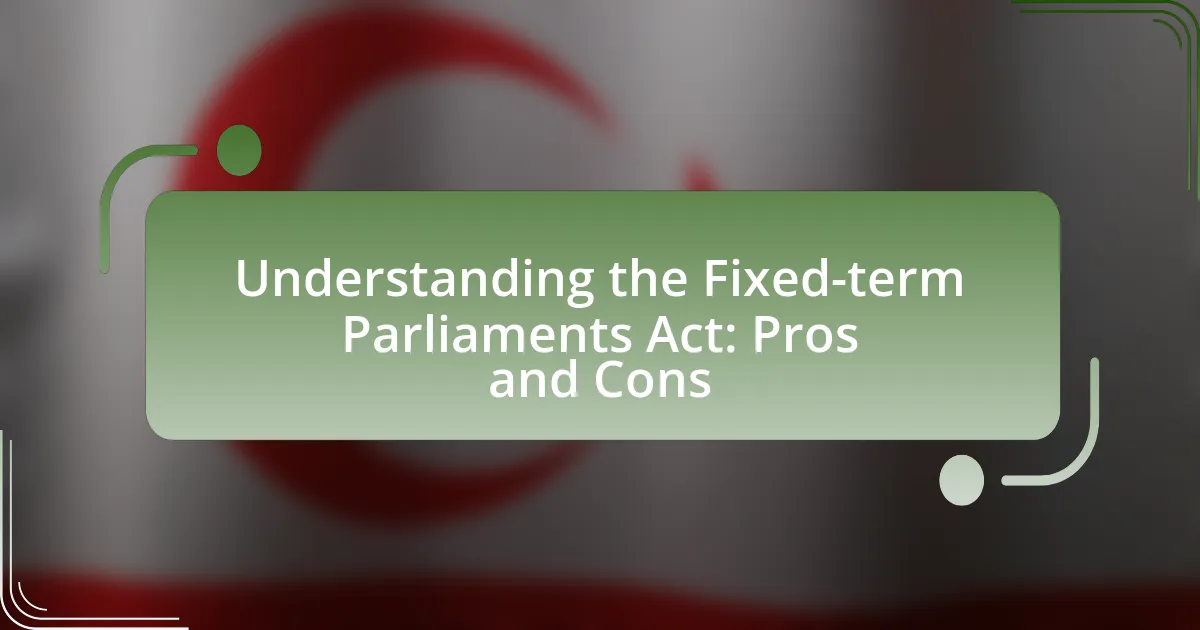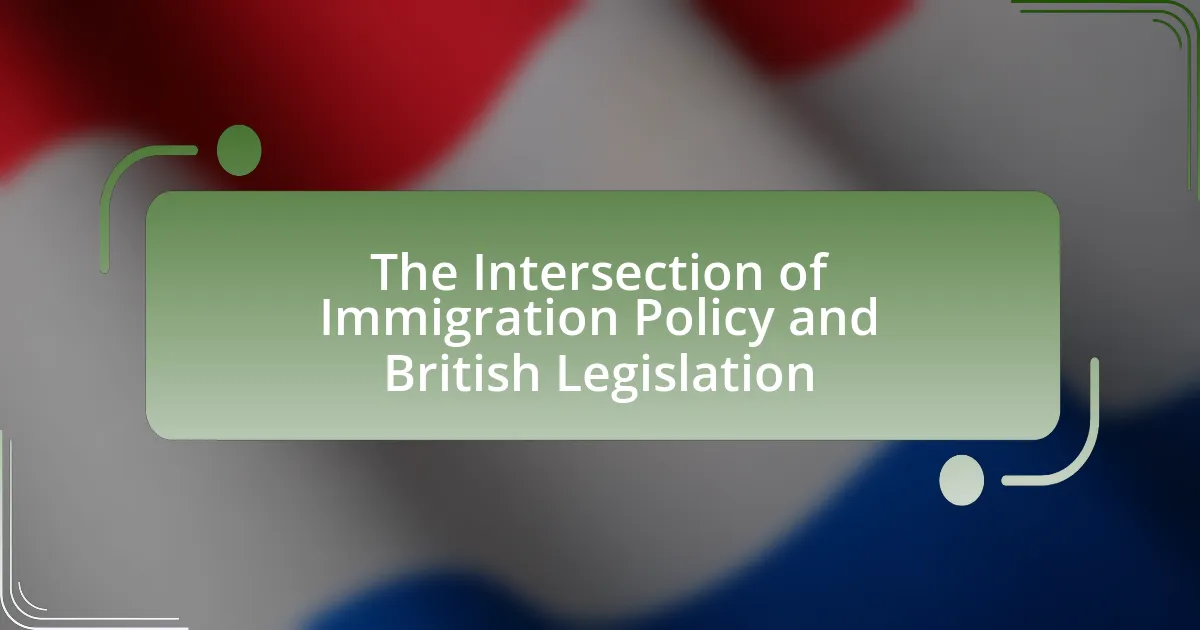The article explores the relationship between the Judiciary and Parliament in the UK, emphasizing the principles of parliamentary sovereignty and the rule of law. It outlines how Parliament serves as the supreme legal authority, while the Judiciary interprets and applies laws, ensuring compliance with constitutional principles. Key interactions, such as judicial review and landmark cases like R (Miller) v Secretary of State for Exiting the European Union, illustrate the checks and balances between these branches. The article also discusses historical developments, current challenges, and potential reforms to enhance governance and maintain the balance of power in the UK legal framework.
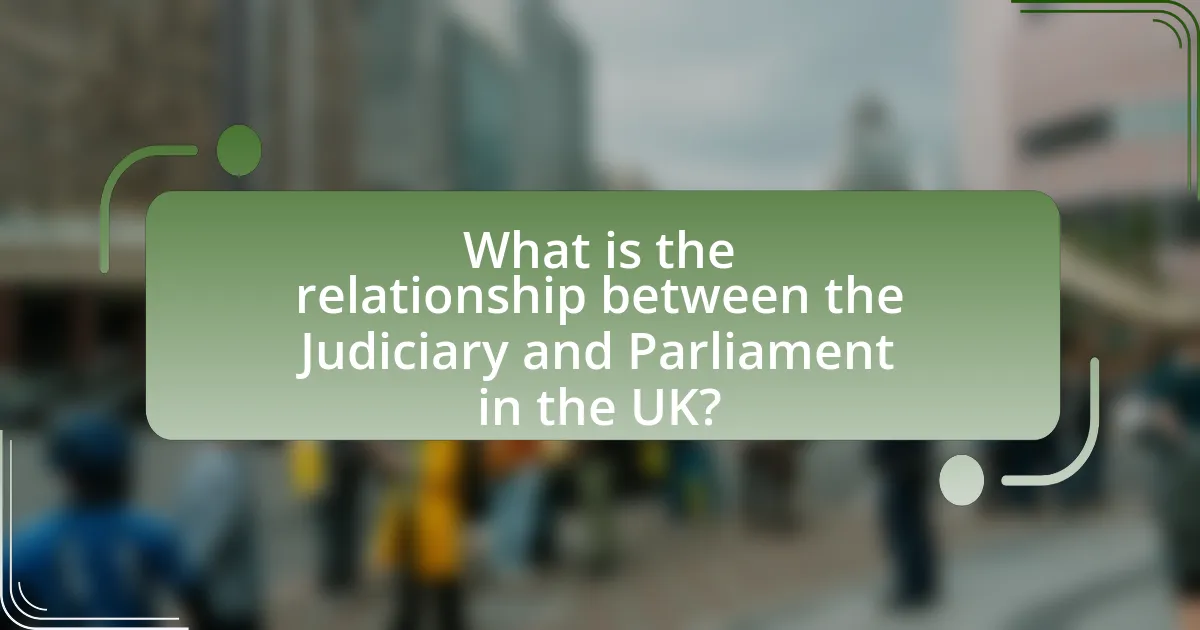
What is the relationship between the Judiciary and Parliament in the UK?
The relationship between the Judiciary and Parliament in the UK is characterized by the principle of parliamentary sovereignty and the rule of law. Parliament is the supreme legal authority, capable of creating or ending any law, while the Judiciary interprets and applies these laws, ensuring they comply with constitutional principles. The Judiciary can review legislation for compatibility with the Human Rights Act 1998, but it cannot overturn primary legislation passed by Parliament. This dynamic is reinforced by the Constitutional Reform Act 2005, which established the Supreme Court as the highest court in the UK, further delineating the separation of powers while maintaining checks and balances between the two branches.
How do the Judiciary and Parliament interact within the UK legal framework?
The Judiciary and Parliament in the UK interact primarily through the principle of parliamentary sovereignty and judicial review. Parliament creates laws, while the Judiciary interprets and applies these laws in individual cases. Judicial review allows courts to assess the legality of parliamentary actions, ensuring they comply with constitutional principles and human rights standards. For instance, the case of R (Miller) v Secretary of State for Exiting the European Union (2017) demonstrated the Judiciary’s role in affirming that Parliament must be involved in the Brexit process, highlighting the checks and balances inherent in the UK legal framework. This interaction ensures that while Parliament has the authority to legislate, the Judiciary maintains oversight to protect the rule of law.
What roles do the Judiciary and Parliament play in the UK governance system?
The Judiciary interprets and applies the law in the UK governance system, ensuring that laws passed by Parliament comply with the constitution and protecting individual rights. The Parliament, composed of the House of Commons and the House of Lords, is responsible for making and enacting laws, representing the electorate, and scrutinizing the government. The Judiciary’s role is exemplified by landmark cases such as R (Miller) v Secretary of State for Exiting the European Union, where the Supreme Court ruled that Parliament must approve the triggering of Article 50, reinforcing the principle of parliamentary sovereignty. This relationship underscores the balance of power, with Parliament creating laws and the Judiciary ensuring their lawful application.
How does the separation of powers influence their relationship?
The separation of powers significantly influences the relationship between the judiciary and Parliament in the UK by establishing distinct roles and responsibilities that promote checks and balances. This framework ensures that Parliament creates laws while the judiciary interprets and applies them, preventing any single branch from wielding excessive power. For instance, the judiciary can review the legality of Parliament’s actions, as seen in cases like R (Miller) v Secretary of State for Exiting the European Union, where the Supreme Court ruled that Parliament must be consulted before triggering Article 50. This interaction underscores the judiciary’s role in upholding the rule of law and protecting individual rights against potential legislative overreach.
Why is the relationship between the Judiciary and Parliament significant?
The relationship between the Judiciary and Parliament is significant because it ensures the balance of power within the UK government. This relationship allows the Judiciary to interpret and apply laws made by Parliament, thereby safeguarding the rule of law and protecting individual rights. For instance, landmark cases such as R v. Secretary of State for the Home Department (2004) demonstrate how judicial review can hold Parliament accountable, ensuring that legislation complies with constitutional principles. This interplay is crucial for maintaining democratic governance and preventing the abuse of power.
What impact does this relationship have on the rule of law?
The relationship between the judiciary and Parliament in the UK significantly impacts the rule of law by ensuring checks and balances within the legal system. This relationship allows the judiciary to interpret and apply laws passed by Parliament, thereby safeguarding individual rights and maintaining legal accountability. For instance, judicial review enables courts to assess the legality of parliamentary actions, reinforcing the principle that no one is above the law. Historical cases, such as the Miller case in 2019, illustrate how judicial intervention can uphold constitutional principles against potential overreach by Parliament, thereby strengthening the rule of law in the UK.
How does it affect the protection of individual rights?
The relationship between the judiciary and Parliament in the UK significantly affects the protection of individual rights by ensuring that laws passed by Parliament comply with constitutional principles and human rights standards. The judiciary acts as a check on Parliament, interpreting legislation and safeguarding against potential abuses of power that could infringe on individual rights. For instance, the Human Rights Act 1998 allows courts to review legislation for compatibility with the European Convention on Human Rights, thereby reinforcing the protection of individual rights against parliamentary actions. This judicial oversight is crucial in maintaining a balance of power and upholding the rule of law, which is essential for the protection of individual rights in a democratic society.

What are the historical developments of the Judiciary and Parliament relationship in the UK?
The historical developments of the Judiciary and Parliament relationship in the UK have evolved significantly, particularly from the 17th century onwards. Initially, the relationship was characterized by the supremacy of Parliament, as established by the Glorious Revolution of 1688, which asserted parliamentary sovereignty over the monarchy and the judiciary. This was further solidified by the Act of Settlement 1701, which ensured judicial independence by securing judges’ tenure.
In the 19th century, the establishment of the Supreme Court of Judicature in 1873 marked a pivotal moment, as it unified the courts and clarified the judiciary’s role in relation to Parliament. The 20th century saw the introduction of the Human Rights Act 1998, which allowed UK courts to interpret legislation in light of the European Convention on Human Rights, thereby enhancing the judiciary’s influence over parliamentary legislation.
The relationship has continued to evolve, particularly with landmark cases such as Miller v. Secretary of State for Exiting the European Union in 2017, where the Supreme Court ruled that Parliament must be consulted before triggering Article 50, reinforcing the principle that Parliament holds ultimate authority. This ongoing dynamic reflects a balance between judicial review and parliamentary sovereignty, illustrating the complex interplay between the two branches of government in the UK.
How has the relationship evolved over time?
The relationship between the judiciary and Parliament in the UK has evolved from a historically subordinate judiciary to a more balanced interaction characterized by judicial independence and parliamentary sovereignty. Initially, the judiciary was seen as an extension of Parliament, with judges often appointed by political figures and subject to political influence. Over time, landmark cases and legislative reforms, such as the Human Rights Act 1998, have reinforced the judiciary’s role in interpreting laws and protecting individual rights, leading to increased judicial review of parliamentary decisions. This evolution is evidenced by cases like R (Miller) v Secretary of State for Exiting the European Union (2017), where the Supreme Court asserted its authority to review the legality of government actions, demonstrating a shift towards a more assertive judiciary that can challenge parliamentary decisions when necessary.
What key events have shaped the Judiciary and Parliament’s interactions?
Key events that have shaped the Judiciary and Parliament’s interactions include the establishment of the Supreme Court in 2009, which marked a significant shift in the UK’s constitutional framework by separating the judiciary from the House of Lords. This change enhanced judicial independence and clarified the roles of both institutions. Another pivotal event was the Human Rights Act of 1998, which allowed UK courts to interpret legislation in light of the European Convention on Human Rights, thereby increasing the judiciary’s influence over parliamentary legislation. Additionally, the Miller case in 2017, where the Supreme Court ruled that Parliament must be consulted before triggering Article 50 to leave the EU, underscored the judiciary’s role in checking parliamentary power. These events collectively illustrate the evolving dynamics and balance of power between the Judiciary and Parliament in the UK.
How did landmark cases influence this relationship?
Landmark cases have significantly influenced the relationship between the judiciary and Parliament in the UK by establishing precedents that define the limits of parliamentary sovereignty and judicial review. For instance, the case of Entick v Carrington (1765) set a precedent for the protection of individual rights against state actions, reinforcing the judiciary’s role in checking parliamentary power. Similarly, R v Secretary of State for the Home Department, ex parte Simms (2000) affirmed that parliamentary legislation must respect fundamental rights, illustrating the judiciary’s capacity to interpret laws in light of constitutional principles. These cases demonstrate how judicial rulings can shape the balance of power, ensuring that Parliament’s authority is exercised within the bounds of law and individual rights.
What constitutional principles govern the relationship?
The constitutional principles that govern the relationship between the judiciary and Parliament in the UK include the rule of law, separation of powers, and parliamentary sovereignty. The rule of law ensures that all individuals and institutions are accountable to the law, which the judiciary enforces impartially. The separation of powers delineates the distinct roles of the judiciary, Parliament, and the executive, preventing any one branch from overstepping its authority. Parliamentary sovereignty establishes that Parliament is the supreme legal authority, capable of creating or ending any law, which the judiciary must uphold unless it conflicts with established constitutional norms. These principles are foundational to maintaining a balanced and functional governance structure in the UK.
What is the significance of parliamentary sovereignty?
Parliamentary sovereignty is significant because it establishes the UK Parliament as the supreme legal authority, enabling it to create or repeal any law without legal limitations. This principle ensures that no other body, including the judiciary, can challenge or invalidate legislation passed by Parliament, thereby maintaining the democratic process and the rule of law. The significance is further underscored by the fact that parliamentary sovereignty has been a foundational element of the UK’s constitutional framework since the Glorious Revolution of 1688, which solidified the Parliament’s power over the monarchy and other institutions.
How does judicial review function within this context?
Judicial review functions as a mechanism through which the judiciary examines the actions of Parliament to ensure they comply with the law and constitutional principles. This process allows courts to invalidate legislation or executive actions that are found to be unlawful, thereby maintaining the rule of law and protecting individual rights. For instance, the case of R (Miller) v Secretary of State for Exiting the European Union (2017) demonstrated judicial review’s role in affirming that Parliament must authorize the triggering of Article 50, highlighting the judiciary’s power to check parliamentary authority when constitutional processes are at stake.
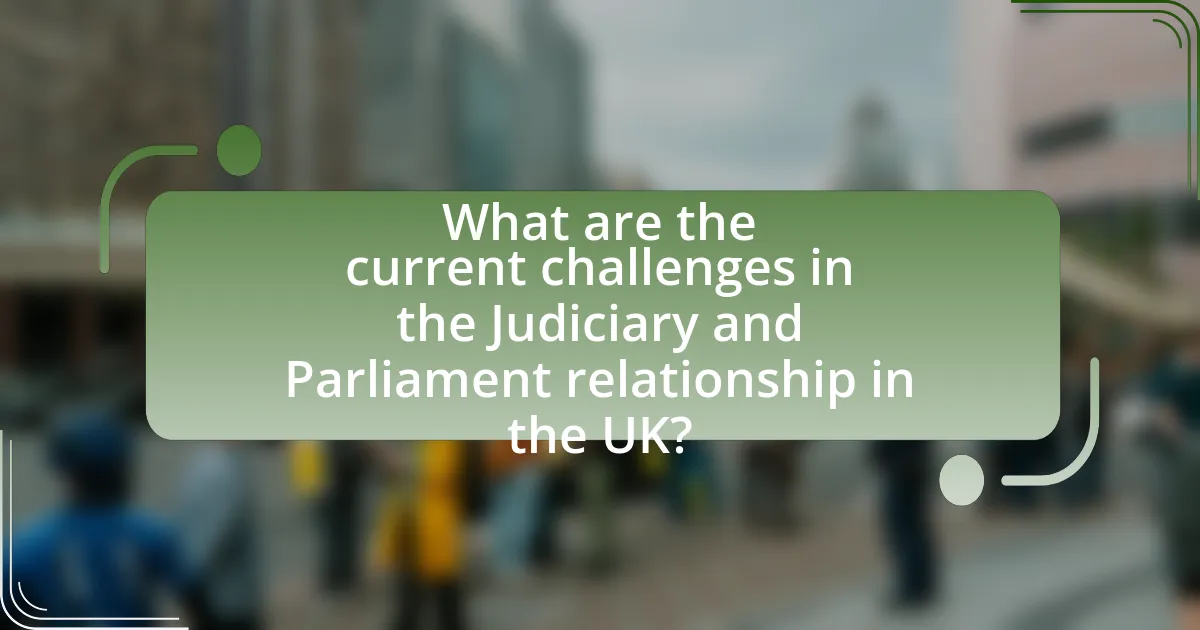
What are the current challenges in the Judiciary and Parliament relationship in the UK?
The current challenges in the Judiciary and Parliament relationship in the UK include tensions over judicial independence, the scope of parliamentary sovereignty, and the impact of recent legislation on judicial review. Judicial independence is increasingly scrutinized as Parliament enacts laws that may limit the judiciary’s ability to review government actions, raising concerns about the balance of power. For instance, the Judicial Review and Courts Act 2022 has been criticized for potentially restricting judicial oversight of executive decisions, which undermines the judiciary’s role as a check on Parliament. Additionally, the increasing politicization of judicial appointments has led to fears that the judiciary may become less impartial, further complicating the relationship between these two branches of government.
What tensions exist between the Judiciary and Parliament today?
Tensions between the Judiciary and Parliament today primarily revolve around issues of judicial independence and the scope of judicial review. The Judiciary asserts its role in upholding the rule of law and protecting individual rights, which sometimes leads to conflicts with Parliament’s legislative authority. For instance, recent court rulings have challenged government actions, such as the Supreme Court’s decision in Miller v. Prime Minister (2019), which ruled that the prorogation of Parliament was unlawful, highlighting the Judiciary’s willingness to intervene in political matters. This has raised concerns among some lawmakers about the Judiciary overstepping its bounds and encroaching on parliamentary sovereignty. Additionally, debates surrounding the Human Rights Act and proposals for reform further exacerbate these tensions, as Parliament seeks to limit judicial influence while the Judiciary aims to maintain its protective role for citizens’ rights.
How do political influences affect judicial independence?
Political influences can significantly undermine judicial independence by creating pressures that affect judges’ decision-making. When political entities exert control over judicial appointments, funding, or legislative frameworks, they can compromise the impartiality of the judiciary. For instance, in the UK, the process of appointing judges has been scrutinized for potential political bias, as government officials may favor candidates aligned with their ideologies. This can lead to a judiciary that is less willing to challenge government actions, thereby eroding the checks and balances essential for a functioning democracy. Historical examples, such as the controversy surrounding the Supreme Court’s ruling on Brexit, illustrate how political reactions can threaten judicial authority and independence.
What role does public opinion play in this relationship?
Public opinion significantly influences the relationship between the judiciary and Parliament in the UK by shaping legislative priorities and judicial interpretations. When public sentiment strongly favors or opposes certain issues, Parliament may feel compelled to enact laws that reflect these views, thereby impacting the judiciary’s role in interpreting and applying those laws. For instance, public opinion on human rights has led to legislative changes that the courts must then interpret, demonstrating how societal attitudes can drive legal frameworks. Additionally, high-profile cases often attract media attention and public discourse, which can pressure Parliament to respond legislatively, further intertwining public opinion with judicial functions.
How can the relationship be improved for better governance?
The relationship between the judiciary and Parliament in the UK can be improved for better governance by enhancing communication and collaboration between the two branches. Establishing regular dialogue forums, such as joint committees or workshops, can facilitate understanding of each other’s roles and challenges. Evidence from the UK Supreme Court’s engagement with Parliament shows that increased interaction leads to more informed legislative processes and judicial decisions, ultimately fostering a more cohesive governance structure.
What reforms could enhance the balance of power?
Judicial reforms that enhance the balance of power in the UK include the establishment of clearer guidelines for judicial review and the introduction of a constitutional court. Clearer guidelines would limit the scope of judicial intervention in parliamentary decisions, ensuring that the judiciary respects the sovereignty of Parliament while still upholding the rule of law. A constitutional court could provide a dedicated forum for resolving disputes between the judiciary and Parliament, thereby clarifying the roles and responsibilities of each branch. Historical context shows that similar reforms in other democracies, such as Germany’s Federal Constitutional Court, have successfully maintained a balance between legislative authority and judicial oversight, reinforcing the effectiveness of such measures.
How can transparency and accountability be increased?
Transparency and accountability can be increased through the implementation of robust oversight mechanisms and public access to information. Establishing independent bodies to monitor judicial and parliamentary actions ensures that both institutions are held accountable for their decisions and processes. For instance, the UK Parliament has the Public Accounts Committee, which scrutinizes government spending, thereby enhancing accountability. Additionally, the Freedom of Information Act 2000 allows citizens to request information from public authorities, promoting transparency. Studies show that increased public access to information correlates with higher levels of trust in government institutions, reinforcing the importance of these measures.
What practical steps can be taken to navigate the Judiciary and Parliament relationship effectively?
To navigate the Judiciary and Parliament relationship effectively, establishing clear communication channels is essential. Regular meetings between judicial leaders and parliamentary committees can facilitate understanding of each branch’s roles and responsibilities. Additionally, creating joint training programs on constitutional law can enhance mutual respect and comprehension of legal frameworks. Evidence from the UK’s constitutional practices shows that such initiatives have historically led to improved collaboration and reduced conflicts, as seen in the establishment of the Judicial Appointments Commission, which promotes transparency in judicial appointments and fosters trust between the two branches.
